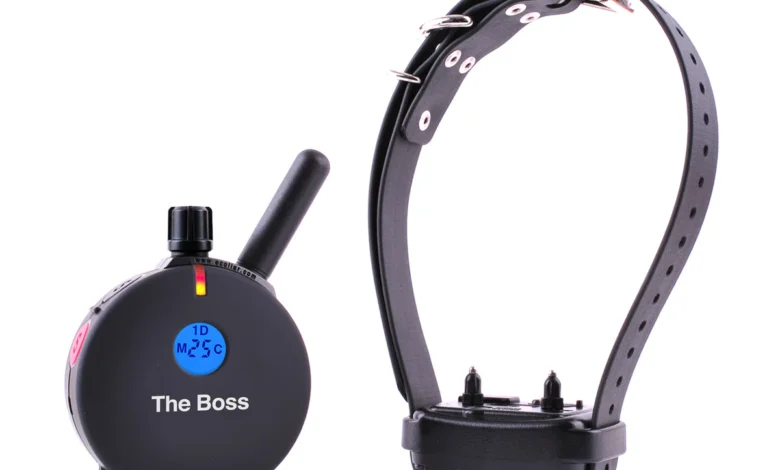
E Collar Technologies, also known as e-collars or remote training collars, are a controversial training tool used primarily for dogs. The collars use electric stimulation to enforce obedience commands.
E-collars were first invented in the 1960s and initially used as a way to remotely track and train hunting dogs. The collars have two main components – a handheld remote control and a receiver worn around the dog’s neck. The remote allows the handler to deliver an electric stimulus, usually between 3000-6000 volts, through contact points on the collar. The intensity and duration of the shock can be adjusted.
Proponents of E Collar Technologies argue they are effective for obedience training and stopping unwanted behaviors like excessive barking. However, critics argue the collars are inhumane and unnecessary for training. There is an ongoing debate about the welfare and ethical implications of using electric stimulation.
This article provides an overview of e-collar technologies, including how they work, the pros and cons of using them, proper training techniques, and alternatives. We’ll also examine the debate around e-collars and what the future may hold for remote training tools. The goal is to provide a balanced perspective on this controversial topic.
What are E-Collars and How Do They Work?
E Collar Technologies, also known as electronic collars or remote training collars, are devices used to train dogs through the delivery of electrical stimulation as a correction or deterrent. The collars consist of two main components – a handheld remote control and a collar receiver worn by the dog.
The remote control allows the handler to deliver an electrical stimulus through the collar receiver on the dog’s neck. Most remotes have multiple levels of stimulation intensity as well as a tone or vibration setting. When a correction is needed, the handler presses a button on the remote which activates the collar receiver to deliver the electrical stimulation.
The collar receiver contains metal contact points that touch the dog’s neck. These contact points deliver electrical stimulation of varying intensity levels when activated by the remote control. Some collar receivers also have the capability to deliver an auditory tone or vibration cue. The electrical stimulation provides a physical distraction or deterrent that is intended to stop or redirect the dog’s behavior.
By pairing the electrical stimulation with verbal commands or other training cues, e-collars can be used to reinforce obedience behaviors or deter unwanted behaviors like barking or chasing. The remote allows the handler to deliver corrections even at a distance. The effectiveness of e-collars depends on proper timing of the stimulation and consistency in training.
Pros of Using E-Collars
E Collar Technologies can provide several benefits when used properly for dog training and behavior modification. One major pro is improved obedience training and control. The electric stimulation offers a way to clearly communicate with the dog from a distance and get their attention for teaching commands or deterring unwanted behaviors. This can help reinforce training and provide clearer cues for the dog to learn faster.
E-collars allow owners to have better control over their dog’s behavior and improve safety. If a dog tends to run off or ignore commands, the collar’s stimulation can interrupt this and get the dog’s focus back on the owner. This can prevent dangerous situations like running into traffic or approaching unknown dogs or people. The improved control can give owners peace of mind in public settings or off-leash.
The stimulation of an e-collar is a versatile training tool that can be used to accomplish various goals. It can be used for basic obedience, walking politely on a leash, housebreaking, preventing nuisance barking, aggression management, and overcoming fears or phobias. The settings allow owners to tailor the stimulation level as needed for training different behaviors. So e-collars provide flexibility to address multiple training challenges with one tool.
Cons of Using E-Collars
E Collar Technologies can be an effective training tool when used correctly, but they also have some potential downsides to consider:
-
Risk of overuse/misuse – If not properly trained on using e-collars, owners may rely on them too heavily or use overly high stimulation levels. This can cause pain, anxiety, and other negative impacts in dogs. It’s essential to follow training protocols and use the minimum effective stimulation.
-
Potential fear/anxiety in dogs – Receiving an unexpected shock can frighten some dogs, especially sensitive breeds. The stimulation may suppress unwanted behaviors through negative reinforcement, but it doesn’t address the root cause. Some dogs can become anxious wearing e-collars. Proper conditioning is required.
-
Considered inhumane by some – Critics view e-collars as unnecessary punishment devices and argue reward-based methods should be used instead. If overused, e-collars can seem abusive. But many also consider them more humane than other aversives when applied correctly. Opinions vary greatly on their humaneness.
E-collars should never be a first choice for behavior modification. Owners must commit to proper training and use only as a last resort after positive reinforcement has failed. With careful use under expert guidance, e-collars can help reinforce commands without harm. But the risks above should not be taken lightly.
Proper Use of E-Collars
Using an e-collar properly is essential to ensuring it is an effective and humane training tool. Here are some key tips:
-
Use the right stimulation level – Always start at the lowest level and work your way up to find the right stimulation level that gets your dog’s attention without overwhelming them. This will vary by dog.
-
Proper timing of stimulation – Precise timing is crucial. The stimulation should be delivered the moment the dog does the undesired behavior to reinforce that it was unwanted.
-
Ensure good understanding of technique – Take the time to thoroughly understand proper e-collar use, like when and how to deliver stimulations. Attend a training class or work with a professional if needed. Rushing into use can lead to misuse.
-
Pair with positive reinforcement – The e-collar should supplement positive reinforcement training, not replace it. Reward your dog for good behavior.
-
Fit the collar properly – Ensure the collar has good skin contact without being overly tight. Improper fit leads to inconsistent results.
-
Limit continuous stimulations – Avoid long stimulations. Use very brief stimulations just to get your dog’s attention.
With proper technique and training, e-collars can be effective while avoiding any undue discomfort, fear or confusion in your dog. Taking the time to learn best practices is key.
E-Collar Training Certifications
E-collar training requires proper education to utilize the tool safely and humanely. There are a few major certification programs available to teach people how to properly use and train with e-collars:
International School for Dog Trainers (ISDT)
The ISDT provides an online course for e-collar training. The certification course covers the history of e-collars, how they function, the proper way to introduce e-collars, effective and humane use of stimulations, troubleshooting issues, and more. The course aims to promote responsible use through education.
Tom Davis System by E-Collar Technologies
E Collar Technologies offers a certification program created by renowned dog trainer Tom Davis. The course focuses on timing, proper fitting of the collar, establishing working levels unique to each dog, and using clear communication. There is also a strong emphasis on relationship building between handler and dog.
Jeff Gellman’s E-Collar Academy
Jeff Gellman’s program provides in-person, hands-on e-collar training. The 2-3 day academy focuses on reading dog behavior, proper fitting and use of the e-collar, and tailoring the training approach to each individual dog. Gellman promotes minimizing stimulations and advocating for limited, ethical use.
The benefits of certified e-collar training are immense. Proper education stresses the importance of clear and consistent communication, building trust between handler and dog, using the minimum effective stimulation, and promoting an overall positive association with the e-collar through reward-based methods. Certifications lead to more success and less risk when using this tool. Responsible e-collar use requires a thorough understanding of canine behavior, psychology, and learning theory.
The E-Collar Debate
E-collars are a controversial training tool, with strong opinions on both sides of the debate. Here’s an overview of some key aspects of the e-collar debate:
Views from Professional Organizations
Professional dog training organizations have varying stances on e-collar use. Some, like the Certification Council for Professional Dog Trainers, prohibit the use of e-collars and promote positive reinforcement. Others, like the International Association of Canine Professionals, accept e-collars as one tool among many for dog training. Overall, opinions among professional groups seem mixed.
Public Perception and Stigma
In the public eye, e-collars are often seen negatively, associated with punishment and abuse. Some see them as “shock collars” and consider them inhumane. However, proponents argue modern e-collars use mild stimulation, not shocks, to get the dog’s attention. Public perception varies, with some more accepting of e-collars for specific applications like off-leash obedience training. But stigma remains among many pet owners.
Legality in Different Areas
Laws regarding e-collar use differ across regions. Some places like Wales have banned e-collars outright. Others like Scotland ban e-collars specifically designed to cause pain and suffering. Some Canadian provinces prohibit e-collar use. In the US, there are no federal regulations, but some states or cities have restrictions. Overall the legal landscape is mixed, with full bans in some areas and no regulation in others.
The debate continues around whether e-collars should be an accepted training method or banned as inhumane. With reasoned use by skilled trainers, e-collars can have value for obedience training. But inappropriate use or misperceptions fuel stigma. The debate will likely continue as laws, professional guidelines, and public opinions keep evolving.
E-Collar Alternatives
While e-collars can be an effective training tool for some dogs, many trainers and owners prefer reward-based methods or tools that don’t use any form of punishment or aversion. Here are some popular alternatives to e-collars:
Reward-Based Training
Reward-based training relies on giving dogs treats, praise, play, and other rewards to reinforce desired behaviors. Instead of correcting undesired behaviors with an e-collar stimulation, reward-based training ignores those behaviors and heavily rewards the ones you want the dog to perform. This positive reinforcement helps dogs learn quickly while building trust and engagement with their handler. Reward-based training takes patience, consistency, and proper timing of rewards, but many trainers find it to be highly effective for most dogs.
Head Halters and No-Pull Harnesses
For dogs that pull on leash, head halters and no-pull harnesses are common alternatives to e-collars. Head halters fit around a dog’s snout and neck to give the handler control of the dog’s head with gentle pressure, making it near impossible for the dog to pull. No-pull harnesses have a front clip so that dogs are turned to the side if they try to pull, stopping the behavior. These tools work by making pulling physically difficult or impossible, rather than using punishment. They take some conditioning for dogs to get used to wearing them.
Martingale Collars
Martingale collars provide more control over a dog’s head and neck compared to a standard flat collar. They can tighten slightly when pulled but do not constrict like choke collars. For dogs that pull somewhat but respond well to corrections, a martingale collar may provide enough extra control without needing an e-collar. As with any tool, proper training is required to use martingales humanely and effectively.
Muzzle Training
For dogs with reactivity issues like lunging and barking at triggers, muzzle training can allow the dog to be safely walked and exposed to stimuli. The muzzle prevents biting so the handler can focus on reward-based training and behavior modification without fear. A muzzle should never be used as punishment and does require conditioning the dog to wear it comfortably. But it can be an excellent alternative for safely managing and training dogs with aggression or reactivity problems.
The Bottom Line
While e-collars work for some dogs’ training goals, reward-based methods and alternative tools like halters, harnesses, and martingales allow owners to successfully train many dogs without using any punishment, fear, pain, or intimidation. Considering reward-based options first for most training goals can build a better relationship with your dog. E-collars do have appropriate uses in specific situations, but should not be the default training tool for all dogs. Trying positive reinforcement and alternative equipment first may provide solutions without ever needing an e-collar.
The Future of E-Collars
E-collars have faced increasing regulation and bans in recent years, with many jurisdictions limiting or prohibiting their use entirely. This trend seems likely to continue as more research emerges on the potential risks of misuse. However, manufacturers continue innovating, adding features for safety and responsible use.
Increasing Regulation and Bans
A growing number of countries have introduced outright bans on e-collars, including Austria, Denmark, Finland, Germany, Norway, Slovenia, Sweden, Switzerland, and Wales. Parts of Australia, Scotland, England, and some Canadian provinces have also enacted restrictions or bans. With increased advocacy and activism against e-collars, along with new scientific evidence, more jurisdictions may follow suit. The tide seems to be turning against allowing unregulated e-collar use.
Innovation and New Features
Even as regulations tighten, companies continue improving E Collar Technologies and introducing features for safer, more humane use. For example, modern e-collars often include:
- Built-in safety cut-offs to prevent over-stimulation
- Stimulation level caps and gradual intensity increases
- Automatic shut-offs after prolonged use
- Temperature sensors to avoid skin irritation
- Enhanced receiver communication to prevent unintended corrections
Manufacturers claim these innovations allow for effective training while reducing risks if misused. However, critics argue no amount of safety features can guarantee humane use. The debate continues.
Role in Training Going Forward
The future role of e-collars in dog training remains uncertain. While popular among some trainers and owners, others view them as unnecessary or inhumane. Much depends on evolving public perceptions and government regulations. Responsible use advocates hope new safety features and training protocols can preserve e-collars as a last-resort training tool in limited contexts. But if bans spread, even such controlled use may be prohibited. For now, e-collars remain divisive, with their long-term place in training unclear. Ongoing developments in regulation and technology will continue shaping the landscape.
Conclusion
E Collar Technologies can be a useful training tool when used correctly, but they also carry risks of misuse or overuse. Here is a summary of some of the key pros and cons to consider:
Pros of E-collars:
- Can help reinforce commands at a distance in off-leash training
- Provides a way to interrupt or deter unwanted behaviors
- Allows trainers to communicate with dogs from far away
Cons of E-collars:
- Risk of overuse, misuse, or abuse if not properly educated on proper stimulation levels
- Requires certified training to be used humanely and effectively
- Does not address the underlying motivation for unwanted behaviors
When using an e-collar, it’s critical to follow best practices like:
- Seeking professional training on proper e-collar conditioning
- Using the minimum effective stimulation level
- Avoiding use on aggressive dogs or puppies under 6 months old
- Ensuring the collar fits properly and making conditioning fun for the dog
E-collars should never be used as a shortcut for comprehensive training or as punishment. With proper education, conditioning, and use, they can be one tool in a trainer’s toolkit. But they are not a magic fix and require time and care to implement humanely.
Ultimately, there are no easy answers to the e-collar debate. Each trainer must weigh the pros, cons, and alternatives to decide what is best for their unique situation and dog. Responsible use that puts the dog’s well-being first is the most important consideration.





